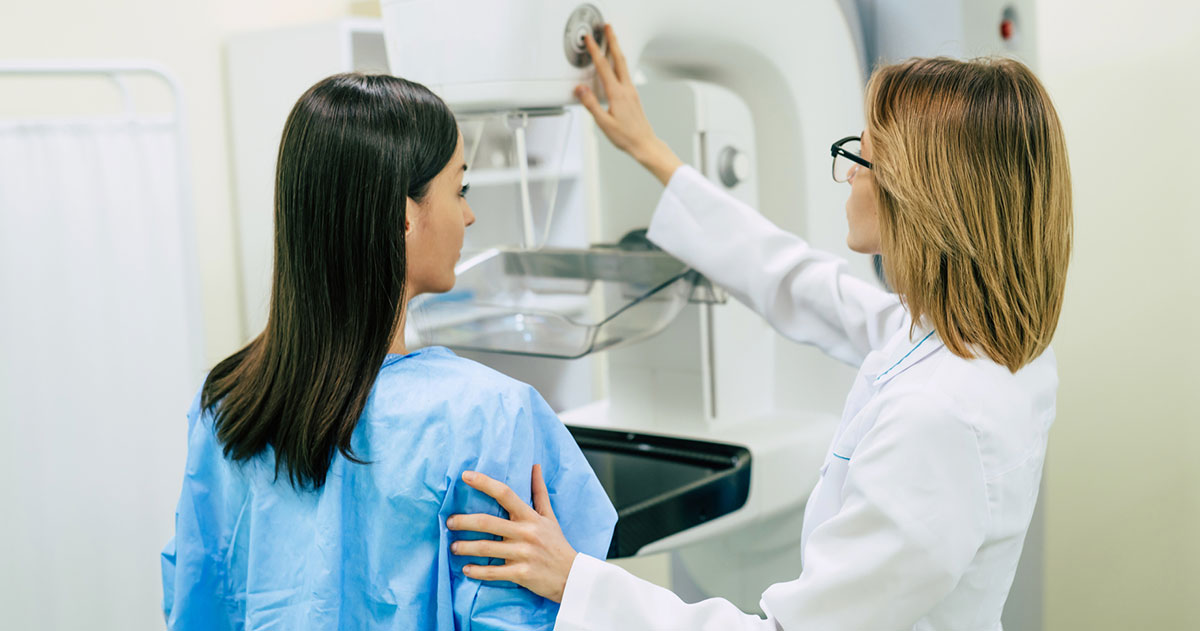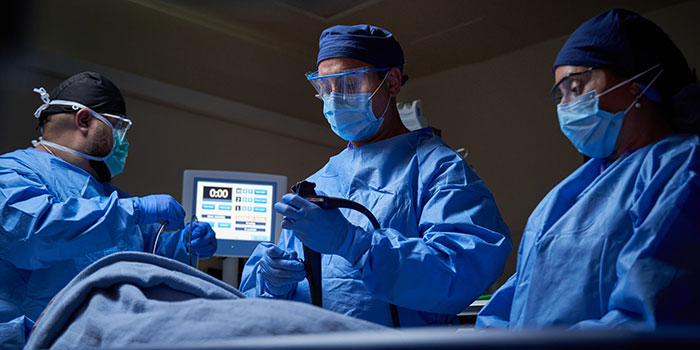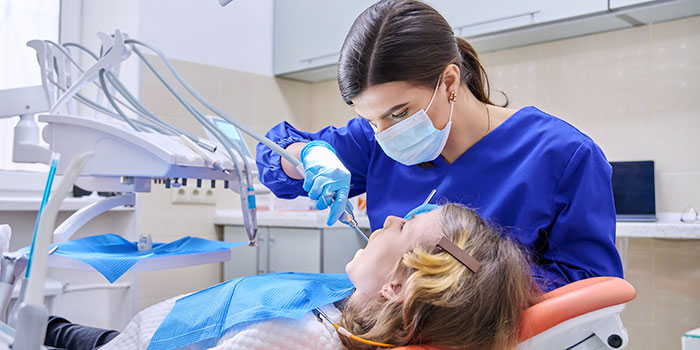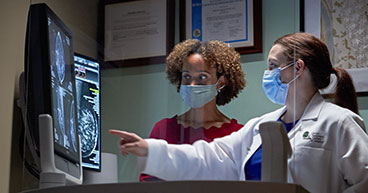
You may think you don’t have time for preventive health screenings like an annual mammogram or skin cancer check, and you wouldn’t be alone. Studies have found that only 8 percent of Americans ages 35 and older receive the recommended preventive services. Other studies have found that women skipped preventive health services more often than men during the COVID-19 pandemic.
Yet staying on top of preventive measures may help boost your overall health, lower your long-term health care costs, improve your quality of life and reduce your risk for developing cancer and other life-threatening diseases.
In this article, we’ll explore which preventive screenings are recommended for women and when, including:
- Mammograms
- Pap tests
- Digital rectal exams
- Colonoscopies
- Skin cancer screenings
- STI tests
- Lung cancer screenings
- Diabetes screenings
- Bone density tests
- Vision tests
- Cholesterol tests
- Dental exams
If you’re interested in getting screened for cancer or if you’ve been diagnosed with cancer and want a second opinion, call us or chat online with a member of our team.
Mammograms
After skin cancer, breast cancer is the most common cancer affecting women in the United States.
As with every type of cancer, when breast cancer is discovered early, there are typically more treatment options available, and survival rates are higher,” says Anita Johnson, MD, FACS, Breast Surgical Oncologist and Chief of Surgery at City of Hope Atlanta.
A mammogram is an X-ray of breast tissue that’s used to identify cancer in the breast. Although opinions differ on how often women should get a mammogram, the American College of Obstetricians and Gynecologists recommends women of average risk for breast cancer receive a mammogram every one to two years beginning at age 40, until age 75.
Pap tests
Cervical cancer used to be one of the most common causes of cancer death for women in the United States. The Pap test helped change that. The Pap test—named for physician George Papanicolaou, MD, who developed the procedure—is a screening exam designed to find changes in the cervix before cancer develops. It may also find cervical cancer early when it’s easier to treat.
Because almost all cervical cancers are caused by the human papillomavirus (HPV), the HPV test may find infections by high-risk versions of the virus that may increase the risk of pre-cancers and cancers of the cervix. The HPV test may accompany a Pap test or be performed on its own.
The American Cancer Society (ACS), recommends cervical cancer screenings beginning at age 25 for women at average risk for the disease, with:
- An HPV test performed every five years
- An HPV test with a Pap test performed every five years
OR
- A Pap test performed by itself every three years
Digital rectal exams
A digital rectal exam allows a doctor to check the lower rectum and pelvis for rectal, uterine or ovarian cancer.
Digital rectal exams are often performed as part of a physical examination. Although no specific guidelines recommend how often a woman should have this test, it’s one of the easiest ways for a doctor to check female organs for signs of cancer or disease.
Colonoscopies
Excluding skin cancer, colorectal cancer is the third-most common cancer diagnosed in the United States. But for the past several decades—since the use of colonoscopies became widespread—fewer people have been diagnosed with colorectal cancer each year.
A colonoscopy is an exam that looks for changes in the large intestine, or colon, and rectum. Changes may include swollen or irritated tissue, polyps or a tumor.
The United States Preventive Services Task Force (USPSTF) recommends women between the ages of 50 and 75 undergo a colonoscopy every 10 years, and women between the ages of 45 and 49 get tested if they have risk factors for the disease. As always, talk to your doctor about your risk for developing colorectal cancer and how frequently you should undergo screening.
At-home tests for colorectal cancer continue to advance in effectiveness, and research suggests their availability may increase the number of people who participate in preventive screenings. Still, if the results of an at-home test come back abnormal, you will need to follow up with a colonoscopy.

Skin cancer screenings
Skin cancer is the world’s most common cancer, affecting one in five people by age 70. Women under age 50 are more likely to develop melanoma—the deadliest form of skin cancer— than any other cancer except breast and thyroid.
Unlike other cancer types, skin cancer develops on the outside of the body and is usually visible. Knowing what to look for may help you detect cancer when it’s easiest to treat.
The Skin Cancer Foundation (SCF) recommends adults see a dermatologist once a year for a full-body, professional skin exam. If you’re at a higher risk of skin cancer, the SCF recommends going to a dermatologist for skin checks more often.
STI tests
If you’re sexually active, getting tested for a sexually transmitted infection (STI), also called a sexually transmitted disease (STD), is one of the most important preventive steps you can take for your health.
Because many STIs may not cause symptoms, it’s vital to have an honest conversation with your doctor about your sexual activity and whether STI testing is right for you.
According to the U.S. Centers for Disease Control and Prevention:
- Adults should be tested at least once for human immunodeficiency virus, or HIV.
- All sexually active women younger than 25 should be tested for gonorrhea and chlamydia once a year.
- All sexually active women 25 years and older with risk factors such as new or multiple sex partners, or a sex partner with an STI, should be tested for gonorrhea and chlamydia once a year.
- Everyone who is pregnant should be tested for syphilis, HIV, hepatitis B and hepatitis C early in pregnancy.
HPV is also considered an STI and women should get screened as recommended above.
The hepatitis B virus (HBV) is an infection of the liver that may lead to liver cancer. HBV may be spread during sex through bodily fluids such as blood and semen. A vaccine is recommended for adults who may be at high risk for HBV, such as health care workers, men who have sex with men, people who use intravenous drugs or those traveling to countries where HBV is more common. In people who are pregnant, having an untreated STI may complicate your pregnancy and may have serious side effects on you and your developing baby. Some of these side effects may show up at birth, but others may not be discovered until years later.
Lung cancer screenings
The second most common cancer is lung cancer in both men and women in in the United States, not counting skin cancer. This year, the ACS estimates 120,800 women will be diagnosed with lung cancer.
Although 90 percent of cases are linked to smoking, lung cancer is rising in people who have never smoked, especially in young women.
The USPSTF recommends annual lung cancer screenings for people who meet all the below criteria:
- Are ages 50 to 80 and in good health.
- Either currently smoke or quit smoking in the past 15 years.
- Have (at least) a 20 pack-year smoking history (the number of packs of cigarettes per day multiplied by the number of years smoked).
Screenings are performed with low-dose computed tomography, or LDCT. These scans may help find abnormal areas in the lungs. Research has found LDCT scans work better than chest X-rays for finding and identifying lung cancer.
Diabetes screenings
Diabetes is a chronic condition that affects how the body turns food into energy. In people without diabetes, the body naturally produces the hormone insulin, which helps convert sugar from food into energy. In people with diabetes, the body either doesn’t make insulin or doesn’t use it well, causing blood sugar to rise and often prompting serious health problems to develop over time.
In the United States, 1.4 million people are diagnosed with diabetes each year, but incidence is rising. According to the American Diabetes Association (ADA), the number of U.S. adults with diagnosed diabetes is expected to increase 165 percent between 2000 and 2050. Plus, about one in five people with diabetes don’t know they have the disease.
Though the link between diabetes and cancer is not completely understood, research indicates that diabetics have an increased chance of being diagnosed with cancer. An ADA report that explored the relationship between the two diseases concluded: "Cancer and diabetes are diagnosed within the same individual more frequently than would be expected by chance."
The USPSTF recommends adults between the ages of 35 and 70 who are overweight or obese—common risk factors for the disease—be tested for diabetes every three years.
Talk to your doctor about whether you should be screened for diabetes—and how often. Diabetes is a manageable condition, especially when it’s found early. Starting treatment quickly may help reduce the risk of complications down the road. So may lifestyle changes, such as a healthy diet and regular exercise.
Bone density tests
Bone density tests check for osteoporosis, which develops when the body either loses too much bone or makes too little of it—or both. A type of X-ray scanner called a DXA machine is typically used for bone density tests. It measures bone density in the hips and spine, where fractures tend to occur in people with osteoporosis.
The USPSTF recommends women 65 and older undergo bone density screenings and repeat testing every four to eight years.
Dental exams
Dental hygiene is about so much more than clean teeth. Research has linked poor oral health to more than a dozen conditions, including heart disease, diabetes, cancer and obesity. Yet 100 million Americans don’t see a dentist each year, according to the American Dental Association (ADA).
Maintaining good oral health with regular dentist visits may help spot signs of oral cancer early, when they may be easier to treat.
People who don't see dentists regularly may develop a big tumor and then get seen by their primary doctor,” says Beomjune Kim, DMD, MD, Head and Neck and Microvascular Reconstructive Surgeon at City of Hope Atlanta. “So, when they’re referred, they often have advanced cancer. Patients who are referred by dentists usually come in with smaller, less advanced cancer.”
The ADA recommends visiting the dentist once or twice a year—or more depending on your specific health needs and risk factors. Regular dental visits may help identify and prevent oral health problems.

Vision tests
Periodic vision exams are an important part of preventive health care. Identifying eye and vision problems early may help ward off vision loss. Different types of vision tests, including visual acuity, evaluate how clearly each eye can see, and refraction, which determines the lens power needed to compensate for a vision deficiency.
The American Optometric Association (AOA) recommends adults ages 18 to 64 receive a vision test at least once every two years. For those at high risk for vision problems and adults 65 and older, the AOA recommends getting a vision test at least once a year.
Vision tests are different from complete eye exams, which look at the back structures of the eye, including the lens, retina and optic nerve. Complete eye exams include dilation to force the pupils to stay open for the duration of the exam. During a complete eye exam with dilation, your doctor may identify problems like a detached retina or a tumor.
The American Academy of Ophthalmology recommends adults at average risk of vision problems get a complete eye examination starting at age 40, when early signs of disease or changes in vision may appear. Your ophthalmologist may then advise you on how often to have your eyes checked going forward. Adults ages 65 and older should have their eyes checked every year or two to look for common age-related diseases like glaucoma and macular degeneration, which may lead to vision loss.
Cholesterol tests
Cholesterol often gets a bum rap, but it’s not inherently bad. The body uses the waxy substance to build cells and make vitamins and other hormones. The problem with cholesterol occurs when you have too much of it. It may build up in the body and increase your risk for heart disease and stroke.
A cholesterol test, also called a lipid panel, evaluates levels of total cholesterol in the blood, including low-density lipoprotein, or LDL, high-density lipoprotein, or HDL, and triglycerides.
You should have your cholesterol checked every five years. However, if you’re obese, have diabetes or hypertension, use tobacco or have a personal or family history of heart disease, you should talk to your doctor about how often you should have your cholesterol monitored.
If you’re interested in getting screened for cancer or if you’ve been diagnosed with cancer and want a second opinion, call us or chat online with a member of our team.


